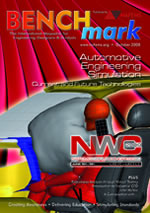BENCHmark October 2008
Automotive Engineering Simulation - Current and Future Technologies

In this Issue:
Why do you use FEA or CFD? At the end of the day, what is the purpose of the simulations that you perform? Of course, we all know that the wide range of answers to these questions is a testament to the successful and widespread adoption of simulation by engineers and scientists. At the end of the day, however, the fundamental answer must be that simulation is performed to provide information about a decision that needs to be made.
That decision might be whether a design needs to be modified: material added or taken away or the shape changed. It might be that the manufacturing process is to be modified, or to suggest the best way in which to repair a broken component….. the list is seemingly endless.
At the same time, the volume of information that a simulation generates to help inform the decision can be enormous. For some applications, the analysis has become so integrated in to the decision making process, and something similar has been done so many times before, that the decision can be partly (or even, sometimes, completely) automated. This is still rarely the case though. In most cases interpreting the results requires considerable expertise.
I believe that a combination of different skills and knowledge are required: a cocktail of engineering know-how, familiarity with the particular application, and of course a good understanding of the analysis, and the implications of all the inherent approximations.
I was reminded of this when I attended our seminar on “Using Finite Element Analysis in Geotechnical Engineering”. I am told that the civil and structural engineering community, whilst significant users of simulation technology, frequently battle with trying to interpret their results in the light of design codes, many of which are tailored to the more “traditional” methods of calculation. They are not alone and a number of industry sectors, and specific organisations, continue to use assessment criteria which have been inherited from previous generations, and should be updated to reflect the adoption of FEA and CFD.
The question then comes about what we, as simulation engineers, are doing to help to achieve this? It is a question that I have been asked many times. The uncomfortable truth is that simulation engineers probably have less influence than we would like with those that are empowered to make these decisions. But things are starting to change, and the awareness of simulation methods has increased dramatically across all walks of engineering. Design codes and standards are starting to be modified to recognise that the calculations which are assessed against their requirements are now likely to be based on some form of numerical simulation.
As this starts to happen, then our job can become a little easier. No longer will we have to over-simplify our results to comply with some archaic requirement. But it is still hard to imagine that the art and skills required for effective interpretation of results will disappear anytime soon!
Tim Morris, Chief Executive
October 2008
The International Congress on Simulation Technology for the Engineering Analysis Community moves to Crete, Greece for 2009.



